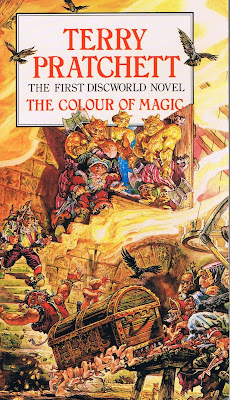© 1983 by Terry Pratchett
Despite flourishing during the prime time of my youth,
I only really became aware of the whole “Discworld” phenomenon after Terry
Pratchett’s death eight months ago at age 66. Wanting to do for fantasy what Blazing Saddles did for Westerns,
Pratchett began a string of 41 irreverent, amusing, and oftentimes off-the-wall
novels over a span of 32 years. The first book, The
Colour of Magic, had an initial printing of 500 copies. Twenty years later
Pratchett was the bestselling UK author of all time, to be surpassed only by J.
K. Rowling.
With a pedigree like that, I had to investigate.
Problem is, over the past eight months I couldn’t find
any of his works in any of the used book stores I prowl about. This signals to
me that the owners of such books wish not to part with them. Which means they’re
that good. (Another author who wrote novels so good that you never find them
in used books stores is Philip K. Dick. Everything of his I read is bought new
off the shelf.)
Then, out of the blue, I stumbled across a copy of The Colour of Magic at my local hometown
library, browsing the shelves while the battery in my Honda Pilot was being
replaced at the gas station across the street. I seized it possessively,
brought it home and bumped it up to the On-Deck Circle of my reading list.
I burned through it in four days around Halloween. It wasn’t
that I couldn’t put it down (had to, ’cuz I was in the thick of getting my own
book onto Amazon), it’s just that every time I picked it up I’d blow through
thirty or forty pages in joyful enrapturement.
The setting of the Discworld series is, well, a disk,
hundreds or thousands of miles across, supported on the backs of four massive
elephants, supported on the back of an even more massive turtle, free-floating
through the universe.
Yes, it’s that kind of tale.
Through four meandering vignettes we follow the
misadventures of a cowardly wizard named Rincewind, and in so doing Pratchett
pokes playful fun at Tolkien, Lovecraft, and Robert E. Howard (he of Conan the
Barbarian literary fame of the pulpy 1930s). Besides Rincewind, the hapless,
bumbling, somehow endearing Bizarro-world Gandalf, we encounter:
Dragons of varying degrees of reality, water trolls,
barbarians, wood nymphs, a Cthulhu-like malevolent deity, a sapient piece of
luggage, a brief segue into the alternate reality of the 1980s (aboard an
airplane), an eighth color (“the colour of magic”), and a spaceship flung off
the edge of Discworld tasked to discover the sex of Great A’Tuin, the turtle on
Whom the world rests. Clocks and cameras appear, powered by little imps. Death
personified, the dude in the black cape with the scythe, is a major character,
always an inch away from claiming Rincewind, and speaking in a unique typeset
way quite pleasing to this logophile.
Rincewind the wizard
contemplating a model of Discworld
It’s funny and witty and downright bizarre. Every page
contains a double-take, a gibe, jest, or joke. Occasionally I’d laugh out loud.
Disconcertingly, I found I’d often have to re-read paragraphs, having detected
a pun flown clear over my head. One-liners as well as page-long jokes unfold
with regularity.
Though the purist in me balked at the lack of
structure, noble purpose, and having beloved fantasy tropes tweaked, the emerging
iconoclast in me relished the trip. It does to fantasy what The Hitchhiker’s Guide to the Galaxy does to science fiction.
One down, forty to go …


No comments:
Post a Comment